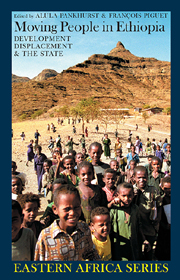Book contents
- Frontmatter
- Contents
- Acknowledgements
- Acronyms
- Glossary
- Notes on Contributors
- Preface: An Original Contribution to Country-wide Displacement Analysis
- Foreword by Alula Pankhurst & François Piguet
- Map
- Part I INTRODUCTION
- Part II THEORETICAL & INTERNATIONAL PERSPECTIVES
- Part III DEVELOPMENT-INDUCED DISPLACEMENT
- Part IV THE EXPERIENCE OF STATE-ORGANIZED RESETTLEMENT
- Part V THE DILEMMAS OF REFUGEES, RETURNEES & DISPLACED GROUPS
- Part VI CONCLUSION
- Bibliography
- Index
- EASTERN AFRICAN STUDIES
Foreword by Alula Pankhurst & François Piguet
Published online by Cambridge University Press: 05 April 2013
- Frontmatter
- Contents
- Acknowledgements
- Acronyms
- Glossary
- Notes on Contributors
- Preface: An Original Contribution to Country-wide Displacement Analysis
- Foreword by Alula Pankhurst & François Piguet
- Map
- Part I INTRODUCTION
- Part II THEORETICAL & INTERNATIONAL PERSPECTIVES
- Part III DEVELOPMENT-INDUCED DISPLACEMENT
- Part IV THE EXPERIENCE OF STATE-ORGANIZED RESETTLEMENT
- Part V THE DILEMMAS OF REFUGEES, RETURNEES & DISPLACED GROUPS
- Part VI CONCLUSION
- Bibliography
- Index
- EASTERN AFRICAN STUDIES
Summary
The aggregate analyses of recent social research glaringly reveal and factually document that new impoverishment is now taking place in Africa. This must be recognized as the biggest paradox, and the most unacceptable, in induced development: the fact that some development programs, although launched, financed, and designed to reduce poverty, end up causing more poverty to a segment of their populations. (Cernea 2005:240)
Development worldwide has increasingly involved population displacement. A recent estimate puts the global figure of annually displaced at 15 million people, adding up to about 280 to 300 million over 20 years. This represents a significant increase on the World Bank estimate in 1994 of 10 million displaced annually by public sector projects alone, or a total of 200 million people (Cernea 2008a:20). Ethiopia is no exception to this trend; population displacement, resulting from development as well as conflict, drought and conservation, has been on the increase since the 1960s. Ethiopia's pivotal position within the Horn of Africa and the internal dynamics between the central highlands and peripheral lowlands, as suggested in our introductory chapter, have been significant features in the country's historical and spatial social formation. Over the past fifty years the state through successive regimes has played a central role in developing the river valleys and lowlands, constructing dams, establishing conservation areas and organizing resettlement.
- Type
- Chapter
- Information
- Moving People in EthiopiaDevelopment, Displacement and the State, pp. xxxi - xliPublisher: Boydell & BrewerPrint publication year: 2009



